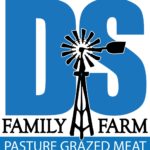Worried about what you are "really" eating? Have peace of mind with pasture grazed meats.
Schedule cows to MOVE!
How is our beef different from 99% of other beef? We keep the herd in MOTION. This requires planning, implementing and tracking. Grazing guru Joel Salatin says it this way, “I’m just the orchestra conductor, making sure everybody’s in the right place at the right time.” His way of saying we are practicing “precision agriculture” 3 R’s; right place, right time and right amount.
The high-tech “precision ag” tools we use every day:
- Braided poly/stainless steel/tinned copper wire
- Electric pulse fencer
- Grazing Schedule – digital maps
The poly wire (1) and electric fencer (2), keeps the herd IN the right place. Our grazing schedule is the tool that keeps everything in MOTION (right time). Folks have developed many different techniques to create and keep up a grazing schedule. We do it with digital maps, very simply, in what is called a geographic information system (GIS).

The most important part of our Grazing Schedule are the principles behind our moves. We use the GIS to help us follow these principles:
- Provide a fresh pasture break nearly every day of the year.
- Prevent re-bite on any fresh grass regrowth.
- Graze, followed by plant rest AND recovery.
- Rotate date of use each year.
- Current animal needs, including wildlife.
Here is a simple example how our Grazing Schedule works:

- View on left, today end of March 2017, the herd is near the large solid orange triangle. The yellow lines outline the paddocks we have grazed this winter (no grass to graze in these small blocks). The larger open areas with question [?] marks are where we could go next.
- In the view on the right, I turned on black lines and “dates” that show our grazing during this time period from a year ago. Last year at the orange triangle (where the herd is now) we grazed in June meeting our principle of not grazing at basically the same time of year. I have placed a yellow [X] over areas that have a [?] mark in the left photo. We want to avoid these areas based on the timing we grazed during the previous year and some other factors.
- So the remaining open areas in the right view are options for where we will graze next.
If you look again at the right view map, note that our “moves” or “paddocks” are rarely the same (yellow lines versus black lines). Most cattle grazing across the country is on permanent pasture areas getting grazed the same year after year. At DS Family Farm our cow herd grazes different patterns across the landscape every year, creating chaos and diversity. We feel this is better for the grass, animals, wildlife and overall ecosystem of our pasture.
We schedule cows to move! This is why we call our beef “Pasture Grazed” and not just “GRASSFED”.





